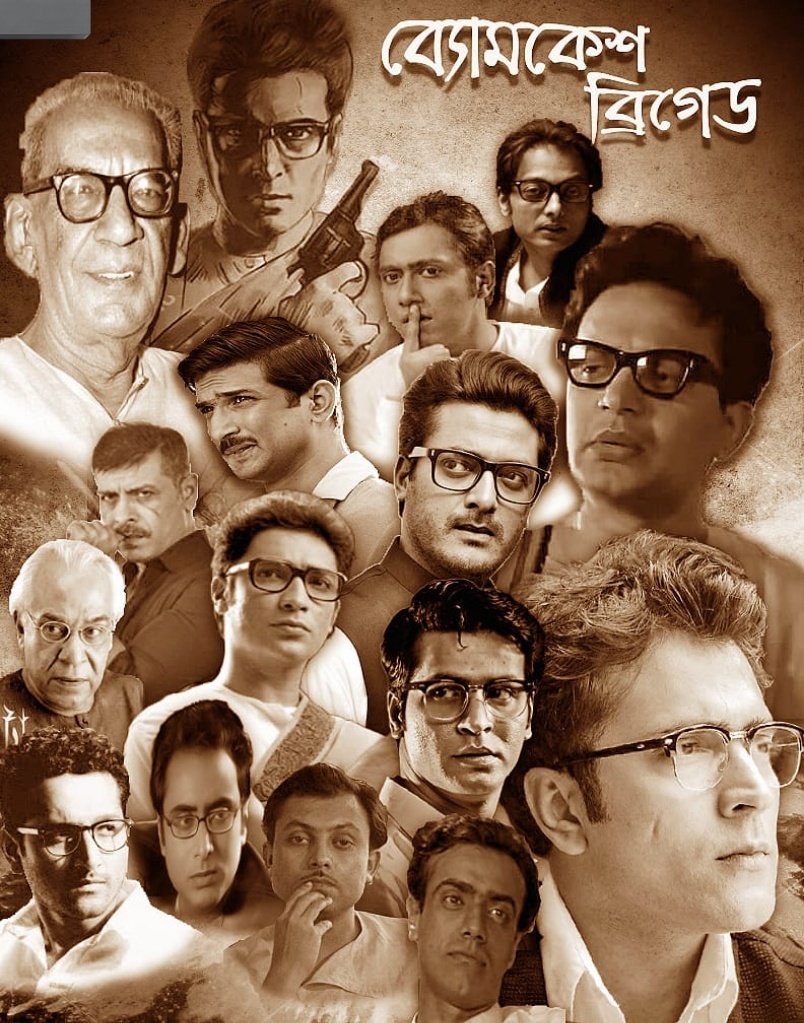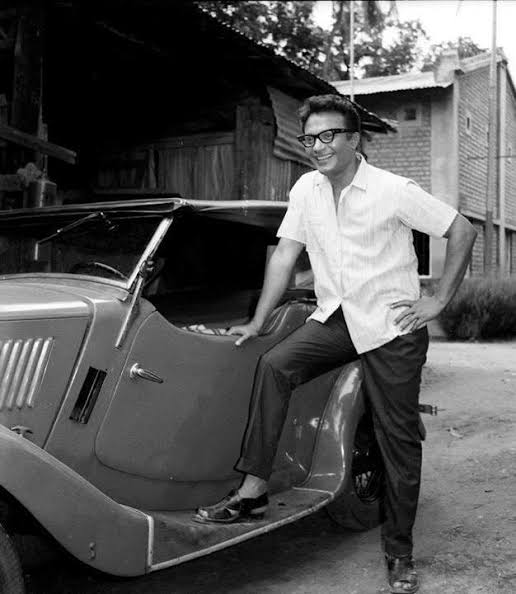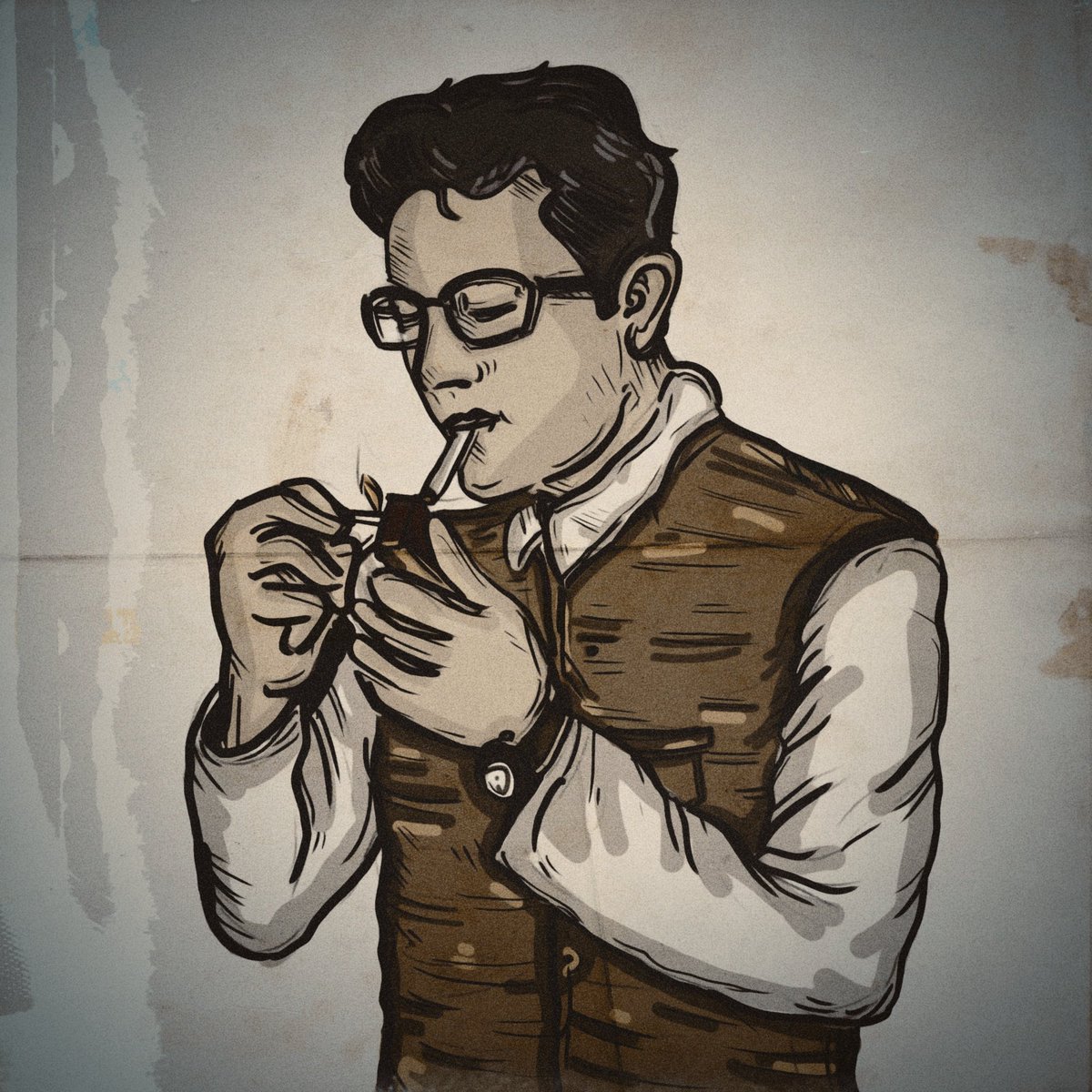The Chiriakhana Chronicles. 👓🔍🕵
A thread 🧵:
While the director may have labelled it as his weakest work, fans hail it as a true cult classic. The final collab between two icons on an iconic character. A detailed sneak peak into the lesser talked world of menagerie and beyond.
A thread 🧵:
While the director may have labelled it as his weakest work, fans hail it as a true cult classic. The final collab between two icons on an iconic character. A detailed sneak peak into the lesser talked world of menagerie and beyond.

*Foundation:
The story of Chiriyakhana begins during the shooting days of Nayak (1966), when Uttam Kumar was impressed by the capabilities of Satyajit Ray's crew members. He proposed the idea of making a film with them,
The story of Chiriyakhana begins during the shooting days of Nayak (1966), when Uttam Kumar was impressed by the capabilities of Satyajit Ray's crew members. He proposed the idea of making a film with them,

offering to charge only half of his usual fee as a goodwill gesture. Overwhelmed by Kumar's proposal, the assistant directors sought permission from Ray and discussed the project's story with him. Ray suggested adapting Saradindu Bandoadhyay's Byomkesh story, with Uttam as lead,
Chiriyakhana, for the big screen, and he would mentor the script, suggest the casting, and his assistant directors would direct the film. The crew members, including Dulal Dutta, Kashinath Basu, Amiya Sanyal, and Punu Sen, formed a production house 

called Star Productions to secure the theatrical rights for the film. They purchased the rights for two thousand rupees from Durgaprasad Chakraborty, who was once Ray's college mate. 

*In search of Fund:
The next challenge was finding a producer for the film. Initially, Nayak's producer and Ray's close associate, R.D. Bansal, was set to produce the film.
The next challenge was finding a producer for the film. Initially, Nayak's producer and Ray's close associate, R.D. Bansal, was set to produce the film.
However, an interesting anecdote emerged that the production had overlooked the strict regulations of the Reserve Bank of India regarding the printing of fake notes during the shooting of Nayak's iconic money sequence. 

As a result, the production was served a legal notice and fined after the film's release, causing Bansal to back out of producing Chiriyakhana.The crew began shooting under Bansal's company for a few days,
but the working director lacked confidence in the project and stepped down, prompting Bansal to also withdraw as the producer. With no financial support, the crew was left in a bind. Fortunately, they found a new producer in publisher Haren Bhattacharya, 

who had one condition: only if Ray himself directed the film he would finance the project. However, Haren Bhattacharya was not satisfied with the previous product and imposed this condition as a way to ensure Ray's involvement. 

*Ray comes on board:
The AD crew found themselves in relief as Ray agreed to helm the film without much discourse. However, Ray made it clear that he would only be involved in directing the film and would not handle any financial matters related to it.
The AD crew found themselves in relief as Ray agreed to helm the film without much discourse. However, Ray made it clear that he would only be involved in directing the film and would not handle any financial matters related to it.

He suggested veteran actor Sushil Majumdar for the role of Nishanath, although initially Ashok Kumar was considered. Ray also selected a location near Bamungachi for constructing the set of Golaap Colony, 

and outdoor portions were shot in a stretch. However, issues arose when it came to shooting indoor scenes. 

*Rift begins to yawn:
The producer was irregular in making payments, causing frequent halts in shooting. Meanwhile, Uttam Kumar got busy with his Hindi venture Chhoti Si Mulaqat, and despite making promises to shoot for Chiriyakhana,
The producer was irregular in making payments, causing frequent halts in shooting. Meanwhile, Uttam Kumar got busy with his Hindi venture Chhoti Si Mulaqat, and despite making promises to shoot for Chiriyakhana,

he failed to keep his word and appeared on the set sporadically. With no progress in the film and the cost of maintaining the set becoming expensive, Ray became increasingly disheartened and lost interest. He eventually ordered the set to be dismantled, 

stating that they would only resume shooting when Uttam Kumar was available and could allot consecutive dates for the film.
One day, Ray angrily threw the script and shouted at his crew, expressing that he would not direct the film anymore. The crew later revealed that they had never seen Ray lose his patience on set before or after that moment, as it was a rare occurrence for him. 

*Satyanewshi's setback:
Mahanayak finally returned after finishing his assignments. The entire climax and revealing scene were left to be shot, which mainly comprised of Byomkesh's dialogues.
Mahanayak finally returned after finishing his assignments. The entire climax and revealing scene were left to be shot, which mainly comprised of Byomkesh's dialogues.
The AD described the day when Mahanayak entered the set and went directly inside the make-up room quietly. Ray was walking around the corridor and did not utter a word. It was already quite late when an AD went inside the make-up room 

and found that Uttam Babu was profusely sweating and lying down almost half-conscious. Suvendu Chattopadhyay was in the cast of the film and a professional medical practitioner. He quickly checked him and reported that Uttam had suffered a heart attack. 

Uttam Babu was taken to the hospital, and he stayed indoors for the next three months as per the doctor's advice. The climax portion was shot when he came back, and finally, the film's shooting was completed.
*The Genius at work:
Interestingly, no music was recorded for the film before its release, except for the single song "Bhalobashar Tumi Ki Jaano". Just before the release, Ray decided to compose the background music and sound design himself.
Interestingly, no music was recorded for the film before its release, except for the single song "Bhalobashar Tumi Ki Jaano". Just before the release, Ray decided to compose the background music and sound design himself.
He requested the crew to give him a day to work on it and hired a truck to transport all his musical instruments to the Grand Hotel. Locking himself in a big room for an entire day, he recorded the entire film's background music and sound effects on a small recorder.
Upon returning home, he recorded the remaining portions on his piano. And thus, the soundscape of Chiriyakhana was created in a single day, showcasing Ray's brilliance and versatility as a composer. 

*Battling the final hurdles:
However, there were hurdles during the film's release when no distributor showed interest in buying it, citing the lack of a well-known heroine in the film.
However, there were hurdles during the film's release when no distributor showed interest in buying it, citing the lack of a well-known heroine in the film.
Eventually, the producer started his own distribution company and initially released the film in three theaters in Kolkata on September 29th, 1967, which proved to be a box office hit. 

The AD crew did not have an official agreement with the producer regarding profit shares. As they had disclosed earlier, it was almost an independent project and they were not paying anyone except Uttam Babu, Ray, and Sushil Babu, others were working voluntarily out of passion.
They managed to clear Uttam Kumar's dues from their own funds but ran out of money while paying Ray. Since Ray was close to the crew, he did not force them to pay him because he knew their financial condition. The crew borrowed some money from the producer to pay Ray.
Ray cleared their debts from the profit share of Ashani Shanket by working with the same production house again.
*Byomkesh faced writer's backlash:
Ray made major changes in the characterisation of the sleuth. He presented Byomkesh as a spectacle and trousers-shirt-wearing, unmarried, middle-aged, middle class sleuth who kept a snake as his pet and lived in a shabby room.
Ray made major changes in the characterisation of the sleuth. He presented Byomkesh as a spectacle and trousers-shirt-wearing, unmarried, middle-aged, middle class sleuth who kept a snake as his pet and lived in a shabby room.

Meanwhile, his companion Ajit Chakraborty was depicted as a married person. There were also other changes in the story. However, the author Saradindu Bandopadhyay was unhappy with the adaptation. 

After the film's release, he wrote a long article in the newspaper criticizing the movie for its hardly and unconvincing depiction of Byomkesh and for being an unfaithful adaptation of the source material. In a nutshell, he harshly criticized Chiriyakhana. 

*Ray's revelations:
Later, Ray himself claimed on multiple occasions that Chiriyakhana was his weakest, unsatisfying & most forgettable work. He realized that the film was not shaping up well from the very beginning & lacked confidence in the script, which was developed randomly.
Later, Ray himself claimed on multiple occasions that Chiriyakhana was his weakest, unsatisfying & most forgettable work. He realized that the film was not shaping up well from the very beginning & lacked confidence in the script, which was developed randomly.

Ray admitted to plenty of faults in the script and the suspense did not unfold as per his vision. He also cited the lack of pre-production, underwhelming production design and random decisions taken on the floor, as well as budget constraints.
Ray said that Chiriyakhana was not entirely or creatively his brainchild. When the film won the National Award, Ray passed a sarcastic comment about the Indian film industry, stating that even films like Chiriyakhana were winning National Awards.
*The legacy of the Menagerie:
However, Chiriakhana remains the only Byomkesh venture to win National Awards for Best Actor and Best Director categories. Uttam Kumar was praised for his efficient performance as Bakshi and won the coveted Bharat Award.
However, Chiriakhana remains the only Byomkesh venture to win National Awards for Best Actor and Best Director categories. Uttam Kumar was praised for his efficient performance as Bakshi and won the coveted Bharat Award.
Although critics criticized the movie for its complex and layered plot and unfaithfulness towards the source material, Uttam's portrayal of Byomkesh became a fan favourite and a landmark performance, everybody was amazed by his radical transformation as the Japanese. 

Despite some date issues, Mahanayak wholeheartedly got involved in the project and even prohibited his assistants from visiting the set who accompanied him everywhere. He desperately wanted to work with Ray again, as just two days before his death,
he asked his associates to contact Manik Da for giving him work, even non-glamorous roles would do. Unfortunately, Chiriyakhana remains the last collaboration between these two icons of the Indian film industry. 

*Snippets of the Satyanewshi:
It's interesting to note that Chiriakhana is the most filmed story of Byomkesh, having been adapted for both the big and small screens numerous times with actors like Rajit Kapur, Gaurav Chakraborty, and others.
It's interesting to note that Chiriakhana is the most filmed story of Byomkesh, having been adapted for both the big and small screens numerous times with actors like Rajit Kapur, Gaurav Chakraborty, and others.

This may be because of its innovative plotline, complex philosophy, and exploration of human psychology through multiple shaded characters.
Another trivia is that Shyamal Ghoshal, who played the doctor in Ray's Chiriyakhana,
Another trivia is that Shyamal Ghoshal, who played the doctor in Ray's Chiriyakhana,

later played the role of Byomkesh in the film Sajarur Kanta. Anjan Dutta also adapted the story for the big screen many years after Ray's version, with Jisshu Sengupta as Byomkesh. In the film, 

Dutta paid homage to Ray by including a closing sequence where a character expresses interest in making a film based on the adventure and casting Uttam Kumar as Byomkesh. In the most recent adaptation titled Byomkesh o Pinjrapol, directed by Sudipto Roy,
Byomkesh Anirban Bhattacharya pays homage to Uttam Kumar by imitating his style of dress, thick black framed glasses, and his manner of speaking "Hello" over the telephone. 

It's worth noting that over 15 actors have portrayed the iconic sleuth on screen in both Hindi and Bengali, with Dev Adhikari being the latest addition to the list. 



*The Cult Sleuth
The journey of Chiriyakhana has been full of ups and downs, making its fate quite intriguing. Nevertheless, it remains a fan favourite and is considered by many to be the best and first on-screen portrayal of Byomkesh.
The journey of Chiriyakhana has been full of ups and downs, making its fate quite intriguing. Nevertheless, it remains a fan favourite and is considered by many to be the best and first on-screen portrayal of Byomkesh.

Ray's iconic contribution to the character, including his trademark black-framed spectacles, has been followed by most creators to date. Interestingly, it was Ray who introduced the spectacles, and it later became almost synonymous with the sleuth's identity.
END
👓🔍

END
👓🔍


• • •
Missing some Tweet in this thread? You can try to
force a refresh























